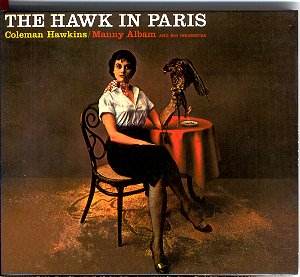
|
COLEMAN HAWKINS
THE HAWK IN PARIS
Coleman Hawkins - Tenor Saxophone with the Manny Albam 0rchestra.
Recorded at Webster Hall N.Y.C. July 1956
RCA Victor Gold Series 74321 851 522
Crotchet midprice
|
1. April In Paris
2. Mon Homme
3. Under Paris Skies ( Sous le Ciel de Paris )
4. Mimi
5. La Chnouf
6. La Vie En Rose
7. La Mer ( Beyond The Sea )
8. Paris In The Spring
9. I Love Paris
10. Mademoiselle De Paris
11. Chien Perdu De Collier
12. Tu N'Peux Pas T'Figurer
The 1950's proved to be a highly productive period for
Coleman Hawkins. A constant stream of albums was released with such
luminaries as J.J. Johnson, Oscar Peterson, Red Allen and Roy Eldridge.
By 1956 Hawkin's tone on tenor had reached its later maturity, characterised
by a certain hardness and gruffness of quality but with an almost disdainful
shrug of the shoulders in its delivery. In my opinion, it is one of
the most beautiful sounds in all of jazz. It is stripped of any frills
or sentimentality and is the mark of a profoundly experienced musician
making a clear and forthright statement of his beliefs.
Hawk first visited Paris in the mid 1930's and acquired a life-long love
for European culture and acceptance . Like many American Jazzmen of his
time it was here that he felt he had garnered the first real appreciation
due to him as an artist.
Whilst recorded in New York this album is comprised of songs associated
with France and with Paris in particular. Hawkins collaborates on these
selections with composer/arranger Manny Albam. This was a musical partnership
that would be re-visited in 1965 with the "Wrapped Tight " session.
The arrangements are highly dramatic but contain many humorous moments
with the insertion of quotes such as "Ta-Ra-Ra-Boom-De-Ay "
from the woodwind in "April In Paris ", the "Can Can "
used as a counter-melody in "La Vie En Rose " and "An American
In Paris " in "I Love Paris."
Throughout these recordings there is a great amount
of interplay between the soloist and the orchestra - this is not just
a "with strings" album. On "Mon Homme " the melody
is stated by the strings to which the saxophone replies. On "La
Vie En Rose " the tenor comes in most dramatically at the middle
eight . Other outstanding moments include the trumpet obligato on "Paris
In The Spring " , the fairground organ effect on the intro of "
Under Paris Skies " and the double - tongued passage at the start
of " Mimi". There is also a great sense of swing to many of
the numbers and an obvious feeling of enthusiasm and commitment on the
part of Hawkins (he can even be heard shouting encouragement to himself
on " La Vie En Rose ").
This recording is essential Hawkins, essential tenor saxophone and essential
Jazz !
Dick Stafford
D.S. is a professional reed player and teacher living in Coventry.